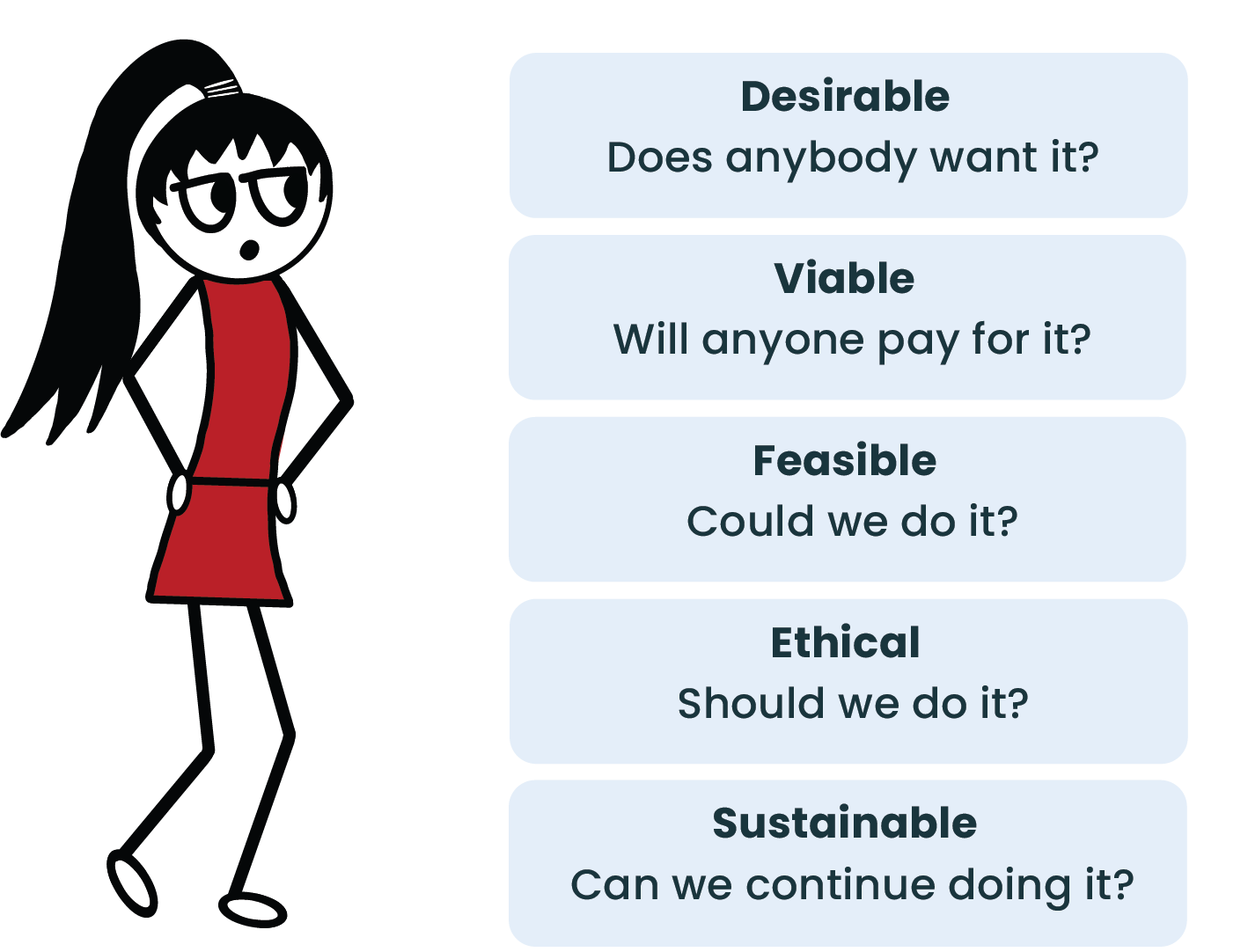From Desirability to Sustainability
There are 5 key questions we should ask are:
I use these 5 questions when I’m running ideation workshops, and to create customer, business, and enabling outcomes, so we can continue to track progress, and raise new issues when they come up.
You can use sticky notes to list the categories, or for the people who love visual prompts, I’ve put a simple map you can download below.
Running a session
I like getting people into teams of 4-6 people, with a mix of skills in each. Depending on the context you might mix sales, technology, product, HR, and finance if working at the leadership level. For product discovery, you might mix technical, design, marketing, and sales in a team. For each category, start by asking ‘What does (the category name)mean to you?’. Get the team to define the category, then give them the prompt questions (below) to check they have covered the key areas. I find it more meaningful to have them come up with the definition than giving them a predefined one.
Get the teams to add sticky notes to capture how they believe their idea will be desirable, viable, feasible, ethical, and sustainable.
Desirable:
“We believe our new AI coaching app will be desirable as people struggle to find the answers quickly when searching online.”
Risk “People will use an existing AI app (Chat GPT) and won’t want to subscribe to a new service.”
Viable:
“We believe our new AI coaching app will be viable as people will pay to use our service.”
Risk “People will use an existing AI app (E.g. Chat GPT) and won’t pay for our service.”
Risk “The transaction cost to run queries using third-party tools will make our app too expensive to run.”
Round 2:
After filling in each category, decide how to test your ideas.
For example “Create a desirability experiment by adding a new product to our website, describing the coaching app, with a sign-up sheet for more information.”
“Create a viability multivariate experiment by testing multiple prices for the coaching app, with a pre-buy button to test how much we could charge, based on click-throughs, that leads to a waiting list.”
Create a feasibility prototype by using third party AI tools to build a working model we can test with customers.
Create an ethical prototype by running the feasibility prototype with real customers, to understand if the app will impact people’s jobs.
Create a sustainable prototype by measuring the energy consumption for the feasibility prototype.
Additional prompts
I’ve added some questions below to help you prompt discussions.
Desirability:
Does anyone want it? Will they use it? What value does it provide?
What problems are we solving? What unmet need are we fulfilling?
What is our big idea? What unique value will we provide to our customers?
How will we test our idea for desirability? (e.g., creating a prototype and testing it with potential customers)
Viability:
Will anyone buy it? How will it help the business?
What’s our revenue model? How will we fund and support our idea?
How will our idea benefit the business? What does success look like?
How will we test our idea for viability? (e.g., a pre-buy button to gauge interest)
Feasibility:
Can we create it? What capabilities must be in place?
What capabilities do we need to develop or leverage to succeed?
What evidence do we have that we can make this happen? What evidence do we need?
Ethical:
What are we worried about? What might keep us up at night?
Does this product respect user privacy and data security?
Are we ensuring fair labor practices and promoting equity?
How do we monitor and measure ethicality? How do we define success in terms of ethical impact?
Sustainable:
What do we need to create a sustainable solution? What risks threaten long-term sustainability?
How do our aspirations support environmental sustainability? Are our partners and suppliers following our sustainability guidelines?
How do we measure sustainability? What metrics will we track?
What governance structures support sustainability?
Sustainability is also about creating long-term growth.Ask ‘How can we continue to grow and sustain our business?’.
As we have seen recently, the race to bring new AI products to market, for many companies, is not sustainable in the long term. While ticking the boxes of DVF, they have failed to account for the high transactional cost of running their products and the high energy cost bringing down their sustainability rating.
Asking about sustaining our products can highlight risks and threats. For example, while it might be feasible to build products quickly by cobbling together third-party tools and code if we don’t understand what’s in the products and code we use, we risk major security and operational threats. A very useful question to ask is “What will keep us up at night?”.


